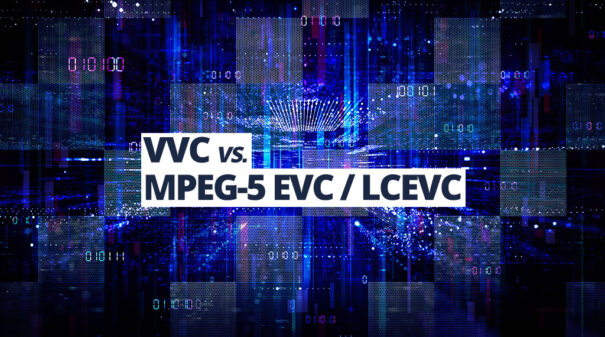VVC vs. MPEG-5 EVC / LCEVC: ¿qué estándar marcará el futuro del broadcast?
En esta Tribuna, el Dr. David Guillermo Fernández Herrera, CTO de AI VIDEX, analiza en profundidad los formatos de compresión de vídeo VVC y MPEG-5 EVC / LCEVC, grandes candidatos para erigirse como estándar en la industria broadcast a corto y medio plazo.
En las últimas décadas, hemos experimentado un increíble avance en el campo de las aplicaciones multimedia. Entre los diversos factores que han intervenido, cabe destacar la contribución de los estándares de compresión de vídeo. Desde finales de los años 80, se han desarrollado multitud de estándares, desde el H.261 al reciente VVC (Versatile Video Coding), siempre buscando obtener grandes tasas de compresión de datos sin reducir la calidad visual.
Este objetivo ha permitido que, cada aproximadamente 10 años, se libere un nuevo estándar que proporciona una reducción del 50% en el ancho de banda requerido respecto a su predecesor. Éste ha sido el caso de H.265/HEVC (High Efficiency Video Coding, liberado en 2013) frente a H.264/AVC (Advanced Video Coding, 2003).
En 2020, se publicó la primera versión del estándar VVC y de otros dos nuevos estándares dentro de la familia MPEG-5, MPEG-5 EVC (Essential Video Encoding) and MPEG-5 LCEVC (Low Complexity Enhancement Video Coding).
Descubriendo VVC
VVC promete reducir en un 50% la tasa de datos generada (bitstream) respecto a H.265. Sin embargo, esta mejora se obtiene a expensas de incrementar considerablemente la complejidad del algoritmo y consecuentemente, requerir mayores recursos computacionales, mayor consumo de potencia y, por lo tanto, mayor coste económico para cumplir los requerimientos que permiten la codificación/descodificación en tiempo real de señales de alta (HD) y ultra-alta definición (UHD). Esto es algo a lo que nos hemos acostumbrado con la liberación de cada nuevo estándar, y VVC no ha sido una excepción, puesto que presenta una gran cantidad de nuevas técnicas que añaden gran complejidad al diseño de un codificador o descodificador.
Tanto la tasa de compression como la calidad visual del vídeo dependen directamente de la implementación realizada en el codificador, de qué técnicas se han utilizado y de cómo se han implementado.
Es muy importante resaltar que los estándares de compresión de vídeo definen la sintaxis del bitstream (cómo construirlo) y el método a seguir para realizar la descodificación (cómo reconstruir un vídeo a partir del bitstream), pero no describen la implementación del codificador. Esto se traduce en que el estándar indica, por poner un ejemplo, cómo convertir un vector de movimiento a una secuencia de bits, pero no define cómo el codificador obtiene el valor de dicho vector buscando el movimiento existente entre las distintas imágenes que componen el vídeo. Tanto la tasa de compression como la calidad visual del vídeo dependen directamente de la implementación realizada en el codificador, de qué técnicas se han utilizado y de cómo se han implementado. Por lo tanto, las prestaciones de un codificador pueden variar significativamente de una implementación a otra.
En las primeras implementaciones de codificadores H.265 se podía corroborar que, cuando se comparaban con implementaciones maduras de codificadores H.264 utilizando configuraciones que permiten emplear la misma cantidad de recursos computacionales (carga de CPU, uso de memoria, etc.), se obtenían mejores resultados en H.264. Actualmente, al ya existir implementaciones de H.265 lo suficientemente maduras, la situación ha cambiado. El objetivo de este comentario es alertar sobre las implementaciones de codificadores que surgen tras la liberación de un nuevo estándar. Algunas son concebidas como meros productos de marketing que incluyen implementaciones sencillas de las nuevas técnicas buscando llegar al mercado lo antes posible, pero finalmente caen por su propio peso al realizar detalladas comparativas con codificadores maduros basados en estándares previos. Las implementaciones realizadas a partir de un estudio exhaustivo del estándar y del estado del arte, y que han sido optimizadas en estrictos entornos de pruebas, son las que realmente explotan las aportaciones de cada nuevo estándar.
Pasos adelante con VVC en el mundo UHD
Entre las aportaciones dentro de VVC, hay que destacar el uso de unidades de codificación de gran tamaño (128×128 píxeles), que permiten reducir enormemente el ancho de banda requerido cuando se aplican en zonas de texturas homogéneas en la resolución UHD. Otra aportación muy interesante es el uso de múltiples tipos de particiones, lo que permite dividir la imagen en unidades de codificación que se adapten al contenido, delimitando perfectamente los diferentes objetos de la imagen. Este nivel de división abre las puertas a la utilización de algoritmos de inteligencia artificial en la compresión de vídeo, como la segmentación, donde cada píxel de la imagen es clasificado individualmente. Mediante segmentación se pueden detectar y delimitar regiones, individuos u objetos de interés en diferentes clases dentro de cada imagen y aplicar diferentes técnicas de compresión según el nivel de calidad visual que se desee obtener para cada clase. Dicho de otra forma, destinar más bits a las regiones de interés para mejorar su calidad visual en función de un análisis de la imagen previo.
VVC proporciona las herramientas necesarias para optimizar la distribución de contenidos en UHD y ya existen implementaciones comerciales que lo posibilitan; pero dichas soluciones utilizan gran cantidad de recursos computacionales y suponen una importante inversión.
Estas herramientas son sólo una pequeña introducción a todas las que utiliza VVC y que, aplicadas correctamente, pueden suponer un salto cualitativo muy importante. Según se publique mayor número de artículos sobre cómo usar eficientemente estas técnicas y se dediquen mayores esfuerzos a optimizar los diferentes algoritmos, se comenzarán a obtener implementaciones de VVC que permitan mejorar las prestaciones de sus predecesores a un coste computacional razonable. VVC proporciona las herramientas necesarias para optimizar la distribución de contenidos en UHD y ya existen implementaciones comerciales que lo posibilitan; pero dichas soluciones utilizan gran cantidad de recursos computacionales y suponen una importante inversión.
MPEG5-EVC / LCEVC: ¿evolución natural?
MPEG-5 EVC presenta la ventaja de disponer de un perfil básico exento de regalías por lo que resuelve una debilidad de H.265, donde la gestión de licencias se ha convertido en un proceso muy engorroso. Pero dentro de la familia MPEG-5, destaca MPEG-5 LCEVC.
Este nuevo estándar se basa en añadir capas adicionales de mejora de calidad sobre una capa base obtenida mediante otros estándares de compresión. Este concepto es un gran salto respecto a sus predecesores, ya que permite que los equipos puedan seguir haciendo uso de aceleración hardware (basada en H.264, H.265, VP9, etc.) para procesar la capa base y, mediante software, mejorar sus prestaciones gracias a las capas adicionales. En el lado del descodificador, si no se soporta MPEG-5 LCEVC, se descodificará únicamente la capa base permitiendo compatibilidad con infraestructuras y dispositivos existentes.
Por lo tanto, MPEG-5 LCEVC introduce el concepto de flujo de datos de mejora de compresión, reduce la complejidad de procesamiento y es compatible con versiones anteriores; todo ello, sin introducir latencia adicional en el sistema.
La adopción de VVC y MPEG-5 LCEVC
Aunque han pasado tres años desde la liberación de la primera versión del estándar VVC, actualmente, no existe soporte hardware en ningún dispositivo para VVC, lo que ralentiza su adopción y nos permite predecir que no se acelerará su expansión hasta 2026 o 2027. Aun sin soporte hardware, estamos viendo una serie de indicadores en el mercado que indican su potencial. Uno de estos indicadores es la adopción de VVC en estándares de aplicación como DVB (adoptó VVC como Next Generation Codec, en 2022), SBTVD (para su capa base, en 2021), SCTE (lo incluyó entre sus estándares en 2023) y su inclusión en ATSC 3.0. El esfuerzo dedicado a la implementación de soluciones VVC por parte de empresas como Qualcomm, Huawei, Hikvision, MainConcept, Ateme o Bitmovin, podría ser otra indicación de su futura amplia adopción.
MPEG5-LCEVC es una realidad palpable, su implantación actualmente es factible, y mediante la adición de capas software tanto en la codificación como en la descodificación, aporta una importante mejora en las prestaciones de cualquier sistema basado en estándares previos.
Debido a la carencia de implementaciones open source maduras de VVC y a los recursos que destinan los codificadores comerciales (8 veces más que H.264 y 4 veces más que HEVC), MPEG-5 LCEVC se perfila como una opción muy interesante para mejorar las prestaciones de sistemas existentes basados en estándares anteriores. Eso sí, en el caso de proveedores de contenidos o servicios multimedia, donde la posibilidad de dedicar potentes servidores a la codificación no sea problema, no se debería perder de vista VVC por las mejoras significativas que aporta en la eficiencia de compresión y por los indicadores sobre su futura adopción que hemos comentado.
A medida que avancen las implementaciones, comenzarán a aparecer dispositivos de menor coste donde sea posible ejecutar VVC. Lo mismo ocurrió con sus predecesores: las primeras implementaciones de H.265 sólo podían ejecutarse en potentes servidores; pero, con el paso de los años, llegaron las implementaciones optimizadas ejecutadas sobre otros tipos de dispositivos como FPGA, GPU y, finalmente, ASIC. Con ello, se llegó a democratizar su uso.
Although VVC en la actualidad no dispone de dispositivos que realicen la descodificación mediante aceleración hardware (móviles, set-top boxes, GPU en ordenadores, etc.), se perfila como el gran candidato for disminuir el ancho de banda requerido para distribuir contenidos UHD en los próximos años.
MPEG5-LCEVC es una realidad palpable, su implantación actualmente es factible, y mediante la adición de capas software tanto en la codificación como en la descodificación, aporta una importante mejora en las prestaciones de cualquier sistema basado en estándares previos. Gracias a la compatibilidad que ofrece, puede desplegarse usando la infraestructura actual y sin necesidad de crear un flujo de datos paralelo, lo cual supone una reducción de costes significativa respecto a la implantación de un estándar que obligue aplicar flujos por problemas de incompatibilidad. No obstante, aunque VVC en la actualidad no dispone de dispositivos que realicen la descodificación mediante aceleración hardware (móviles, set-top boxes, GPU en ordenadores, etc.), se perfila como el gran candidato para disminuir el ancho de banda requerido para distribuir contenidos UHD en los próximos años.
Al final, serán las apuestas de broadcasters, fabricantes y proveedores, así como necesidades específicas en el cada vez más amplio concepto broadcast, quien definirá el ganador en una batalla con dos tecnologías muy potentes que llegan a solventar muchos de los desafíos que implica la transmisión de contenido HD y UHD.
Dr. David Guillermo Fernández Herrera
CTO de AI VIDEX
Did you like this article?
Subscribe to us RSS feed And you will not miss anything.















